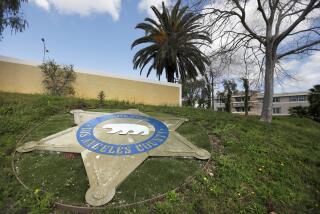A gang truce, a war of words
- Share via
To the Editor:
In his review of “Street Wars: Gangs and the Future of Violence” [June 13], Edward Humes quotes Santa Monica’s police chief saying that my version of a 1998 gang truce was “insane.” Then Humes claims that I “glossed over” the fact that a gang peacemaker in question, Miguel (Michael) Herrera, later was convicted of murder.
It is unethical and unprofessional to quote the police chief without asking my response, but even worse to repeat the police version of the Herrera case without any questions.
Were Humes a reporter instead of a biased pundit, he would have discovered that the Santa Monica Police Department withheld evidence during the Herrera trial in 2002. The police chief has an interest in diverting attention from this fact.
The background is this: In 2000, a carload of gang members from the Sotel gang drove into Santa Monica shouting epithets and were fired upon by unknown Santa Monica gang members, resulting in one death. Herrera was arrested as an accessory and convicted in a 2002 trial.
Santa Monica’s police chief had sharply discredited Herrera’s role in ending the 1998 violence, claiming instead that a law enforcement crackdown had done the job. In fact, rivals from two gangs reached a cease-fire agreement by themselves in my state Senate office, with Herrera present.
The evidence withheld in Herrera’s trial was a Discovery Channel videotape showing bloodhounds sniffing the track of the last person to touch the bullets used in the shooting. The tape, which I have seen, clearly shows the bloodhounds climbing up the staircase of an apartment house. But a Santa Monica homicide detective testified that they went down a stairwell to the place where weapons allegedly were stored.
I’m not a bloodhound, but I smell something rotten.
The Times’ reviewer shamefully failed to investigate the smears he reported.
Tom Hayden
Santa Monica
*
Edward Humes replies:
Tom Hayden illustrates a central theme of “Street Wars” with a grave allegation against Santa Monica’s chief of police: that the chief broke his word and arrested a gang “peacemaker,” thereby nearly sabotaging a gang cease-fire and discouraging future peacemaking efforts. Now Hayden suggests that reporting the chief’s response to this incendiary claim is unfair.
Hayden couldn’t be more wrong: Only a failure to seek the chief’s response could be deemed unfair in these circumstances. Contrary to Hayden’s assertions, simply reporting the chief’s denial of the book’s allegations represents no endorsement of official views, nor could any rational analysis deem it a “smear.”
As for Miguel Herrera, who was not named in the review (except by the common gang moniker “Pee Wee”), Hayden concedes he was convicted of murder. This is neither opinion nor smear, it is simply a fact. Hayden may be right, that the conviction could be a wrongful one worthy of being overturned, but you wouldn’t know it by reading “Street Wars” -- the book is silent on these matters. Give Hayden credit for chutzpah, though, in taking The Times to task for his own glaring omissions.
*
Editor’s note: A Superior Court judge is scheduled Sept. 23 to hear a defense motion seeking a new trial for Herrera based on the tape.
More to Read
Sign up for Essential California
The most important California stories and recommendations in your inbox every morning.
You may occasionally receive promotional content from the Los Angeles Times.









